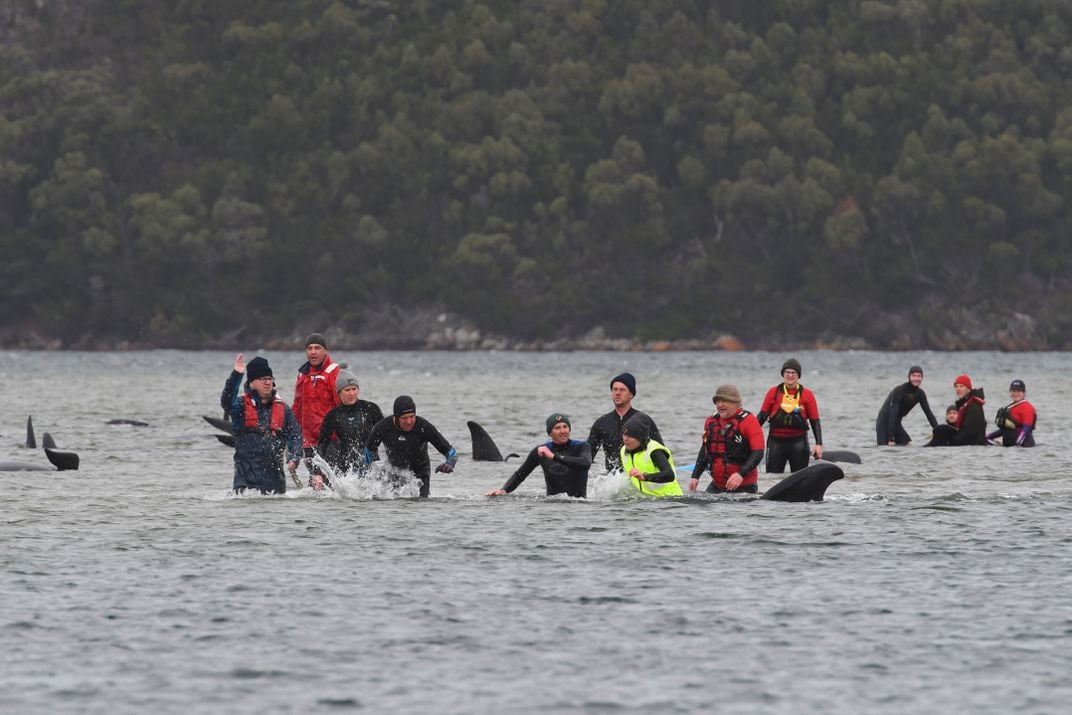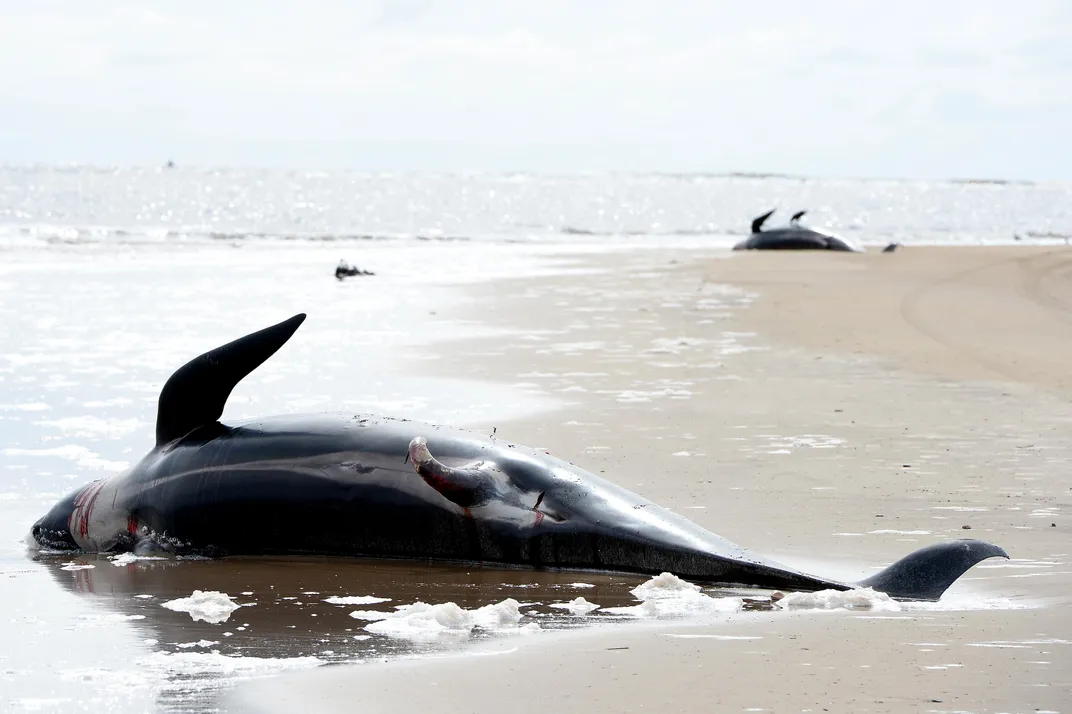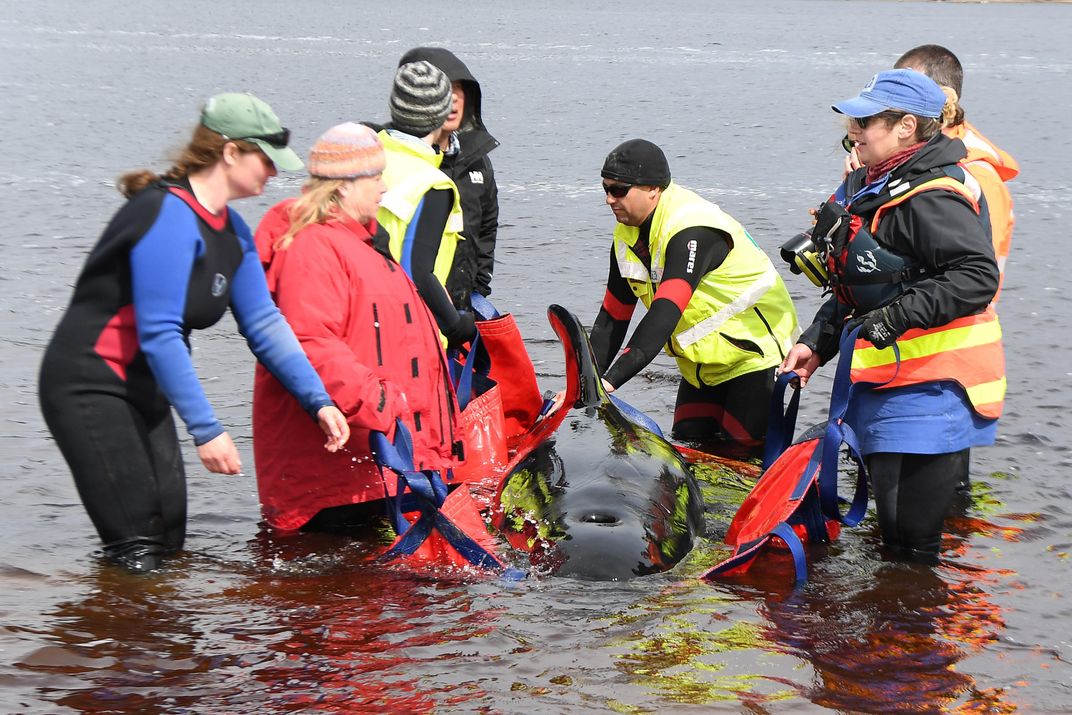Hundreds of Whales Die in Mass Stranding in Australia
Nearly 500 pilot whales were stranded off the coast of Tasmania last week, in what officials say is the largest mass stranding event in Australian history
/https://tf-cmsv2-smithsonianmag-media.s3.amazonaws.com/filer/6b/c6/6bc60399-a82b-48d2-a7f7-3025c6407340/gettyimages-1228646690.jpg)
An estimated 470 pilot whales were beached along the shore and two sandbars on the western coast of Tasmania last week, in what is believed to be the largest mass stranding event in Australia’s history.
As of Saturday, about 360 whales had died, reports Damien Cave for the New York Times, but a team of more than 60 workers were able to save 108 whales by the end of a five day rescue effort. Now, clean up efforts begin as teams corral the corpses using water booms until they can be properly disposed of at sea.
“Collection and disposal is being undertaken with the assistance of aquaculture companies whose equipment and expertise on the harbor is essential for a timely and effective outcome,” Rob Buck, the manager of Tasmania's Parks and Wildlife Service, said in a statement.
Hundreds of the whales were discovered on Monday, September 21, on Tasmania’s west coast, in an area known as Macquarie Heads. By Wednesday, an additional 200 whales were discovered further into the harbor.
Kris Carlyon, a marine biologist leading the Tasmanian government’s efforts to save the remaining whales, said at a news conference on Tuesday that the team was focused on rescuing the survivors before turning to the dead whales.
“This was a natural event, so we can accept that we are going to lose some animals,” Carlyon said, reports Graham Readfearn for the Guardian. “This is such a tricky event … that any whale we save we are considering a real win. We are focusing on having as many survivors as we can.”
Pilot whales can grow up to 25 feet long and weigh up to three tons, which complicates rescue efforts. Rescuers had success putting a large sling under the whales and then slowly pulling the creature off the sand, Tasmania Parks regional manager Nic Deka tells the Guardian. Each trip took about 30 minutes per animal, as the team needed to get the whale far enough away from its peers that it wouldn’t try to turn around and swim back.
“It’s just a matter of steering them. These animals have been in a reasonable shape. They tend to want to return to the pod—they’re very social— so we have to get them far enough away,” Deka tells the Guardian.
The whales’ problems don’t end when they reach open ocean, marine scientist Vanessa Pirotta told Australian broadcaster ABC. “They are wanting to return back to the pod. They might hear the acoustics of the vocalizations of the sounds that the others are making, or they’re just disoriented, and in this case extremely stressed, and just probably so fatigued that they in some cases don't know where they are,” Pirotta says.
Mass whale strandings are relatively common, but scientists don’t yet know exactly why they occur, as Brigit Katz noted for Smithsonian magazine last year. Whales are most likely to beach on shallow, sloping shores made of soft sediment. Some strandings might result from miscommunication: sonar noises from human activity or even solar storms might throw off whales’ navigation or spur them to move quickly away from a strange sound.
Toothed whales, like pilot whales, are more likely to be involved in mass strandings because they travel in large pods of up to 1,000 members, reports Laurel Wamsley for NPR. These tight-knit social dynamics may result in a “persistence to keep the group together”—so if a pod matriarch mistakenly swims in the direction of dangerous shallower waters, the whole pod may follow, according to the American Cetacean Society.
Once the whales are stranded on the soft sand, they become exhausted and stressed, which makes it difficult to free themselves, reports the New York Times.
This stretch of coast in Tasmania is known as a hotspot for strandings. In 1935, the last time a mass stranding of pilot whales of this magnitude occurred in Tasmania, 294 whales beached themselves. As the Times reports, this is the first mass stranding event involving more than 50 pilot whales since 2009.
Elsewhere in the region, in 2017, more than 400 pilot whales were beached along the shallows of Farewell Spit in New Zealand, as Lauren Young reported for Smithsonian magazine at the time.
/https://tf-cmsv2-smithsonianmag-media.s3.amazonaws.com/accounts/headshot/nora.png)



/https://tf-cmsv2-smithsonianmag-media.s3.amazonaws.com/accounts/headshot/nora.png)